重庆市江津第五中学八年级英语上册 Unit 4 How do you get to school
八年级英语上册 unit4 How do you get to school学案 人教新目标版
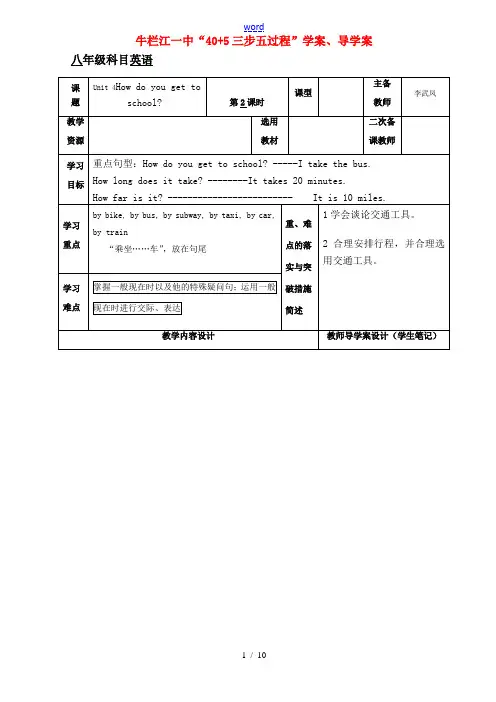
B:Yes,it is.
A:Do you go to school by bike or by bus?
B: 2 sometimes I'm late. Then I go to school by bus.
A:What time do you begin classes?
B:At eight.
A:Are the classes over in the middle of the day.
2 His mother didn’t ________(寄) him any money
from Beijing this week.
3 Miss Green doesn’t like going__________(离
师 开)away for too long. 生 4 Bill has to stay at home and __________(临时 互 照顾) his little sister. 动 5 He sent a __________(明信片) to his friend
7.--___________ is it from XingNing to HuangYuan? ----Ten minutes’ walk.
7 / 10
选句子完成对话
A:Hello,Mike! 1
word
B:Hello,Sam.I'm going to school.
A:Is the school near your home?
breakfast------------------------------
quick
2. 早班车 ------------------------------
八年级英语上册Unit4《Howdoyougettoschool》文字素材1人教新目标版
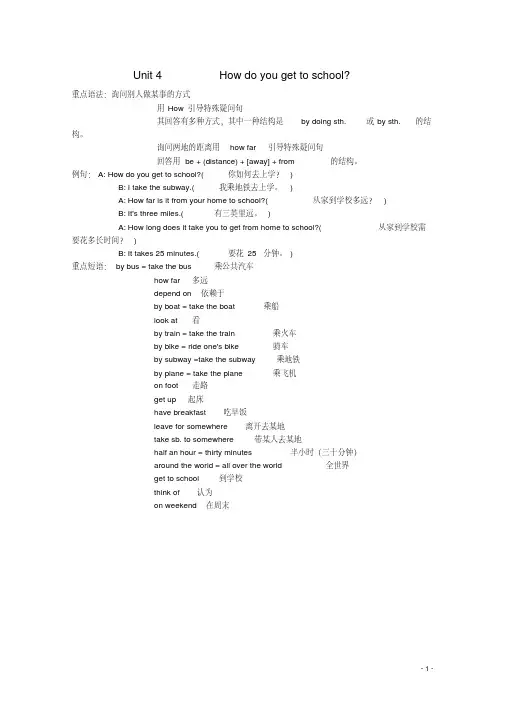
Unit 4 How do you get to school?重点语法:询问别人做某事的方式用 How 引导特殊疑问句其回答有多种方式,其中一种结构是 by doing sth. 或 by sth. 的结构。
询问两地的距离用 how far 引导特殊疑问句回答用 be + (distance) + [away] + from 的结构。
例句:A: How do you get to school?(你如何去上学?)B: I take the subway.(我乘地铁去上学。
)A: How far is it from your home to school?(从家到学校多远?)B: It's three miles.(有三英里远。
)A: How long does it take you to get from home to school?(从家到学校需要花多长时间?)B: It takes 25 minutes.(要花 25 分钟。
)重点短语:by bus = take the bus 乘公共汽车how far 多远depend on 依赖于by boat = take the boat 乘船look at 看by train = take the train 乘火车by bike = ride one's bike 骑车by subway =take the subway 乘地铁by plane = take the plane 乘飞机on foot 走路get up 起床have breakfast 吃早饭leave for somewhere 离开去某地take sb. to somewhere 带某人去某地half an hour = thirty minutes 半小时(三十分钟)around the world = all over the world 全世界get to school 到学校think of 认为on weekend 在周末- 1 -。
(整理)初中英语八年级上册Unit 4 How do you get to school教学设计
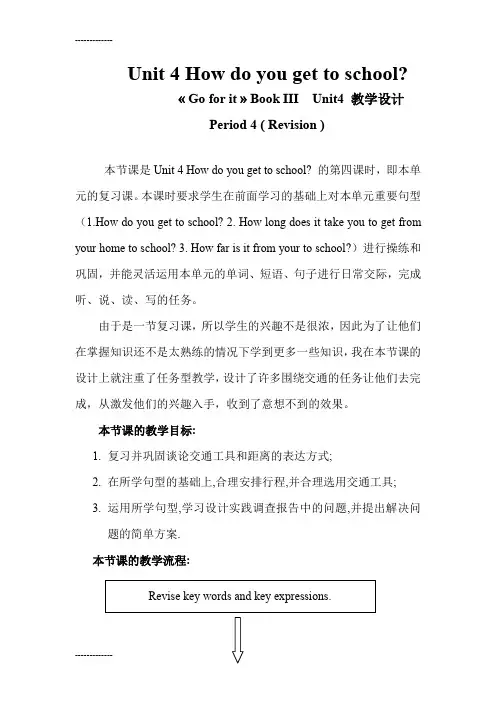
Unit 4 How do you get to school?« Go for it » Book III Unit4 教学设计Period 4 ( Revision )本节课是Unit 4 How do you get to school? 的第四课时,即本单元的复习课。
本课时要求学生在前面学习的基础上对本单元重要句型(1.How do you get to school? 2. How long does it take you to get from your home to school? 3. How far is it from your to school?)进行操练和巩固,并能灵活运用本单元的单词、短语、句子进行日常交际,完成听、说、读、写的任务。
由于是一节复习课,所以学生的兴趣不是很浓,因此为了让他们在掌握知识还不是太熟练的情况下学到更多一些知识,我在本节课的设计上就注重了任务型教学,设计了许多围绕交通的任务让他们去完成,从激发他们的兴趣入手,收到了意想不到的效果。
本节课的教学目标:1.复习并巩固谈论交通工具和距离的表达方式;2.在所学句型的基础上,合理安排行程,并合理选用交通工具;3.运用所学句型,学习设计实践调查报告中的问题,并提出解决问题的简单方案.本节课的教学流程:本节课的教学过程:Step1 RevisionRevise the key words, expressions and sentences in this unit. And write down some key points on the blackboard. Let students make up sentences using some of the words. For example:the words are transportation 、subway、mile、calendar and so on.Step 2 Pairwork This activity provides oral practice using the target language.1. Ask students to have a conversation about how to get to Book Shop. 设计情景:Alice wants to go to Xinhua Bookshop in Shiqi, but she doesn’t know the way. Can you help her how to get there?2. Teacher says: Now work with your partner: make your own conversations about how Alice get to Xinhua Bookshop in Shiqi . You can use the words in this unit.3. Ask some pairs to present their conversations to the class.Step 3 Listening T his activity gives students practice in understanding the target language in spoken language.1.Play the recording for the first time. Students only listen.2.Then play again. This time ask them to answer the questions oflistening material.3.Check the answers.1). What’s John? (A worker.)2). How does he go to a bus station?(By bike. )3). Where does he take a bus to?(The River Stop.)4). How does he get across the river?(By boat.)5). How does he get to his factory at last?(He walks to his factory.)Step 4 Listening material.John is a young man. He works in a factory in a new town. But he lives far from his factory. Every day he gets up very early. He eats breakfast at home. Then he goes to a bus station by bike. There he takes a bus to get to the River Stop from the bus station. There is no bridge across the river. He does the same thing every weekday.Step 5 Assign some tasks. This activity provides oral and written practice using the target language.Task 1: Make up a travel plan.此活动为四人或六人小组活动。
新目标八年级上unit4howdoyougettoschool教学设计
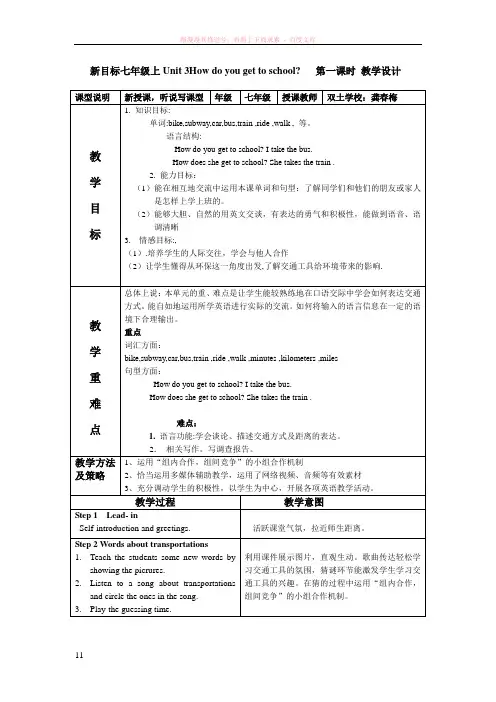
新目标七年级上Unit 3How do you get to school? 第一课时教学设计课型说明新授课,听说写课型年级七年级授课教师双土学校:龚春梅教学目标1. 知识目标:单词:bike,subway,car,bus,train ,ride ,walk , 等。
语言结构:How do you get to school? I take the bus.How does she get to school? She takes the train .2. 能力目标:(1)能在相互地交流中运用本课单词和句型:了解同学们和他们的朋友或家人是怎样上学上班的。
(2)能够大胆、自然的用英文交谈,有表达的勇气和积极性,能做到语音、语调清晰3. 情感目标:,(1).培养学生的人际交往,学会与他人合作(2)让学生懂得从环保这一角度出发,了解交通工具给环境带来的影响.教学重难点总体上说:本单元的重、难点是让学生能较熟练地在口语交际中学会如何表达交通方式。
能自如地运用所学英语进行实际的交流。
如何将输入的语言信息在一定的语境下合理输出。
重点词汇方面:bike,subway,car,bus,train ,ride ,walk ,minutes ,kilometers ,miles句型方面:How do you get to school? I take the bus.How does she get to school? She takes the train .难点:1. 语言功能:学会谈论、描述交通方式及距离的表达。
2.相关写作。
写调查报告。
教学方法及策略1、运用“组内合作,组间竞争”的小组合作机制2、恰当运用多媒体辅助教学,运用了网络视频、音频等有效素材3、充分调动学生的积极性,以学生为中心,开展各项英语教学活动。
教学过程教学意图Step 1 Lead- inSelf-introduction and greetings. 活跃课堂气氛,拉近师生距离。
(八年级英语教案)新目标英语八年级上Unit4Howdoyougettoschool

新目标英语八年级上Unit4Howdoyougettoschool八年级英语教案新目标英语八年级上unit 4 how do you get to schoolsection a教案●一、teaching material analysis《新目标英语》的语言教育理念是:知识用于行动,强调“语言应用”,培养“创新、实践、能力”,发展“学习策略”。
那么本节课作为unit4的section a,教材以how do you get to school?为中心话题,围绕“traffic way”展开,运用一般现在时。
section a与学生的实际密切相关,易于引发学生用英语进行交际交流,完成听说读写的任务活动,我将灵活运用这些活动,将其中的一些活动进行变化或整合。
通过对本课的仔细诊断,把教学策略重点地位在三个教学环节上,即presentation ,practice and production上,将“激发兴趣,激活思维,轻松导入,读后仿说,逐层训练,强化能力,创设情景,迁移知识,实现目标”作为本课的设计导向。
●二、teaching aims:1、技能目标:学生能听懂本课录音;能听懂师生之间就本课内容而展开的一切形式的问答;会和别人展开对话,了解和传递信息;能将本课重难点理解透彻,灵活恰当运用;无大的语言错误;就类似话题创造性地自编对话,掌握比较级的用法。
2、知识目标:take subway train forty ninety hundred minute kilometerhow do you get to school? how long does it take?3、情感目标:让学生感受到他们学习英语是为了在现实生活进行交流,而不单纯是为了英语课和应付考试而学习;让学生感受到他们是英语学习活动中的主体和中心,以此来激励他们在英语课上积极参与,追求创新,使学生爱学英语,爱说英语,想说口语。
4、学习策略目标:改变传统的死记硬背,积极主动的投入到语言的实践中去,用英语去思考问题,在实践中提高语言的综合使用能力,加深对基础知识的掌握和记忆,学会使用brains storing 。
八年级英语上册Unit4Howdoyougettoschool知识点总结人教新目标版
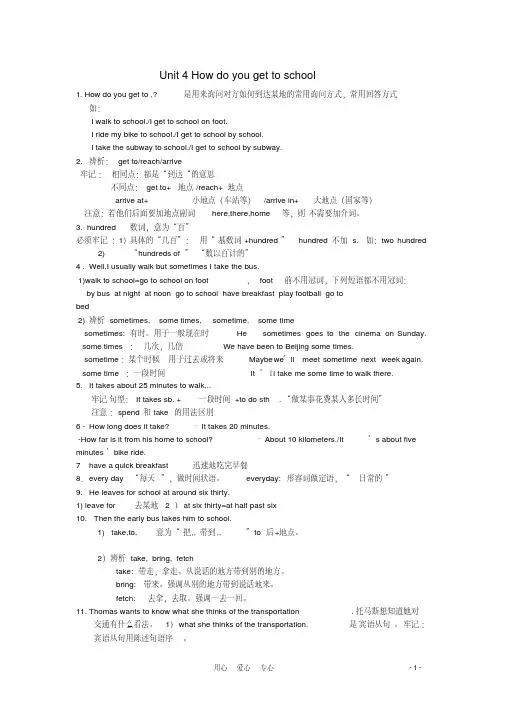
Unit 4 How do you get to school1. How do you get to ,?是用来询问对方如何到达某地的常用询问方式,常用回答方式如:I walk to school./I get to school on foot.I ride my bike to school./I get to school by school.I take the subway to school./I get to school by subway.2. 辨析: get to/reach/arrive牢记:相同点:都是“到达“的意思不同点:get to+地点/reach+地点arrive at+小地点(车站等)/arrive in+大地点(国家等)注意:若他们后面要加地点副词here,there,home等,则不需要加介词。
3. hundred 数词,意为“百”必须牢记:1)具体的“几百”:用“基数词+hundred”hundred不加s.如:two hundred 2)“hundreds of”“数以百计的”4 .Well,I usually walk but sometimes I take the bus.1)walk to school=go to school on foot, foot前不用冠词,下列短语都不用冠词:by bus at night at noon go to school have breakfast play football go tobed2)辨析sometimes, some times, sometime, some timesometimes:有时。
用于一般现在时 He sometimes goes to the cinema on Sunday. some times:几次,几倍 We have been to Beijing some times.sometime:某个时候用于过去或将来Maybe we’ll meet sometime next week again. some time:一段时间It’ll take me some time to walk there.5.It takes about 25 minutes to walk,..牢记句型:It takes sb. +一段时间+to do sth.“做某事花费某人多长时间” 注意:spend和take的用法区别6 -How long does it take? –It takes 20 minutes.-How far is it from his home to school? –About 10 kilometers./It’s about five minutes’bike ride.7 have a quick breakfast迅速地吃完早餐8.every day “每天”,做时间状语。
重庆市江津第五中学八年级英语上册 Unit 4 How do you get to school(第
Unit 4 How do you get to school(第1课时)【学习目标】:1. 知识目标:词汇:get to, subway, , train hundred minute短语: get to school, get home, how about=what about, take the subway, ride a bike, take the bus, take the train, take a taxi, , by bike, bike bus, by subway, by taxi, , by train,2. 能力目标:学会谈论交通工具3. 情感目标:合理选用交通工具【重点】: how 引导特殊疑问句Teachers’ words: A lazy youth, a louse age.(少壮不努力,老大徒伤悲。
)预习案【使用说明及学法指导】借助课前预习案,掌握基础知识。
2.对照所列出的基础知识进行背诵,找出自己的薄弱只是进行强化记忆。
3.完成时间20分钟;1.翻译下列短语,并熟练掌握1)到达_____________________ 2)乘地铁_______________________________3)乘火车_____________________ 4)乘小汽车_______________________________5)步行去------___________________6)骑自行车_______________________________ 7)多远 _________________ 8)多久_________________9)多久一次______________二、自主学习1. hundred数词,“一百”。
若hundred前有具体的数字,则直接用“基数词+hundred”.There are five hundred students.易错点提醒:若表示“数百的”的约数概念,则用hundreds of. Thousand, million也有类似用法。
八年级(上)Unit 4 How do you get to school说课稿
八年级(上)Unit 4 How do you get to school说课稿一、说教材(一)、教材的地位和作用本单元以how do you get to school?为中心话题,围绕交通方式而绽开,主要运用how long/how far 询问“去某地的交通方式、时间、距离。
”简洁描述路线。
这一话题贴近同学们的日常生活,它继第三单元谈论“假日方案”后支配这样一个话题,符合同学的认知结构和年龄特征,它将为后几个单元的学习打下坚决的语言基础。
而seetiona第一课时重点则采访同学们上学的交通方式,及花费的时间、距离等等。
(二)、教学目标(语言学问力量目标情感目标)语言学问:1、语言目标,把握语汇subway 、train、 bus、 car、bus stop等。
语言功能:学会谈论并描述交通方式语言结构:学习把握how引导的特别疑问句:how do you get to school? how long does he get to school?how long does it take?要求同学把握好助动语do在不同人称,特殊是第三人称单数后的变化。
2、语言技能1、能依据录音推断交通的方式,花费的时间及距离。
2、能询问他人到达某地的交通方式并转述。
力量目标:1、培育同学听、说、读、写的力量。
2、训练同学小组合作的力量。
3、让同学通过有用的目标语言学会与他人沟通的力量。
情感目标:鼓舞同学学会关怀别人,关心别人。
(三)、教学重点和难点重点:关心同学学会使用how do you get to school?i take the train to school.how does he get to school?he takes the bus to school.进行交际难点:区分take 的用法。
二、说教学方法(一)、学情分析1、初二同学经过学校和学校的学习,已经有了肯定的英语基础学问和听说力量,正渐渐向读写过渡,同时,同学们对英语学习还保持着较深厚的爱好。
八年级初二英语上册教案Unit 4 Unit4 How do you get to school 1
How does he get to school? He gets to school on foot/by car...
I take a car/ride a bike…to school.
过程
方法
municative teaching method
She takes the subway to school. She gets to school by subway.
Oral English practice.
教学难点
The difference between〝I take the subway to school〞and〝I get to school by subway〞
“I take the bus.”
Pair work
激发学生的学习兴趣。
引入新单词与句型
练习新句型
教学用具
CAI
教学过程设计
教学内容及教师活动
学生活动
设计意图
Step 1 Greeting
Step 2 Group work
Show the students a cartoon with a video on the screen. And ask the students that how manymeans of transportation are there in it. What are they?
2) Ask students to practice in pairs.
3)Say“I Байду номын сангаасalk to school. I can also
Greeting.
八年级上册英语Unit4《Howdoyougettoschool》知识点
八年级上册英语Unit 4《How do you get to school》知识点【短语归纳】1. take the subway = go to … by subway搭地铁2. take the train = go to … by train坐火车3. take a bus = go to …by bus = go to … on a bus乘坐公共汽车4. take a taxi = go to … by taxi坐出租车5. ride a bike = go to … by bike骑自行车6. walk = go to … on foot步行7. take a car = go to … in a car = go to … by car坐汽车8. get to school 到达学校9. 10 kilometers from school 离学校10公里(远)10. from his home to school 从他家到学校11. how far(用于提问距离)多远12. have a quick breakfast 快速地吃早餐13. leave for school 出发去学校14. the early bus 早班车15. take sb. to school 带某人去学校16. bus ride 搭公车的路程17. bus stop 公车亭18. bus station 公车站19.train station 火车站20. subway station 地铁站21. think of 认为22. around the world=all over the world 遍及全世界23. in North America 在北美洲24. on the school bus 乘/坐校车25. in other parts of the world 在世界上的其他地方26. the other (两者中的)另一个27. others = other (students)其他的(学生)28. things are different 情况不同29. be different from 与…不同be the same as与…一样30. make a difference 产生差异31. depend on 取决于/依赖/依靠32. go to school by boat = take a boat to school 坐船去上学33. must be 肯定/一定是34. the most popular ways 最流行的方式means of transportation 交通方式35. a small number of 小部分的36. a large / great number of 大多数的37. ill in the hospital 生病住院38. worry about sb. /sth. 担心某人/某事【固定结构】1.It takes / took (sb.)some time to do sth. 做某事花了某人…时间/ 某人花了…时间做某事(重要考点)It takes me 20 minutes to finish all my homework. 我花了20分钟的时间完成了所有的作业。
- 1、下载文档前请自行甄别文档内容的完整性,平台不提供额外的编辑、内容补充、找答案等附加服务。
- 2、"仅部分预览"的文档,不可在线预览部分如存在完整性等问题,可反馈申请退款(可完整预览的文档不适用该条件!)。
- 3、如文档侵犯您的权益,请联系客服反馈,我们会尽快为您处理(人工客服工作时间:9:00-18:30)。
Unit 4 How do you get to school(第1课时)
【学习目标】:
1. 知识目标:词汇:get to, subway, , train hundred minute
短语: get to school, get home, how about=what about, take the subway, ride a bike, take the bus, take the train, take a taxi, , by bike, bike bus, by subway, by taxi, , by train,
2. 能力目标:学会谈论交通工具
3. 情感目标:合理选用交通工具
【重点】: how 引导特殊疑问句
Teachers’ words: A lazy youth, a louse age.(少壮不努力,老大徒伤悲。
)
预习案
【使用说明及学法指导】
借助课前预习案,掌握基础知识。
2.对照所列出的基础知识进行背诵,找出自己的薄弱只是进行强化记忆。
3.完成时间20分钟;
1.翻译下列短语,并熟练掌握
1)到达_____________________ 2)乘地铁_______________________________
3)乘火车_____________________ 4)乘小汽车_______________________________
5)步行去------___________________6)骑自行车_______________________________ 7)多远 _________________ 8)多久_________________
9)多久一次______________
二、自主学习
1. hundred
数词,“一百”。
若hundred前有具体的数字,则直接用“基数词+hundred”.
There are five hundred students.
易错点提醒:若表示“数百的”的约数概念,则用hundreds of. Thousand, million也有类似用法。
考题再现
--what’s the matter, Kangkang?
--oh, I feel sorry to hear more than _____people lost their lives in the earthquake in Sichuan.
A. sixty thousands of
B. sixty thousand
C. six thousand of
D. thousand of
探究案
一、合作探究
Pairwork Talk about how to get to school.
1. How do you get to school?
2. —How long does it take you to get from home to school?—It takes 25 minutes.
二、拓展创新Survey. .
三、梳理归纳
1. take VS by
take v. 1) 乘,坐,搭(车船,等交通工具) My brother takes the subway to work.
2) 花费(时间) It takes(took) sb. Some time to do sth. It takes him an hour to go to work everyday.
by prep. 以…方式 by bus; by plan; by air
四.根据提示,回忆 how 的相关问句用法。
学习建议:鉴于前面的语法学习与探究,要在积极动脑思考和总结规律的基础上,对语法的特例进行归纳。
训练案
一、重点句型体验:划线提问下列各句。
1. He goes to work on foot everyday.
_______________________________________________________________________________ _____
2. It takes me half an hour to do the maths problem.
_______________________________________________________________________________ _____
3. The hospital is about 2 kilometres from our school.
_______________________________________________________________________________ _____
4. This school begins classes at 7:4
5.
_______________________________________________________________________________ ______
二、用单词的适当形式填空
1. When it ____________ (rain), I’ll take a taxi.
2. It took them a year ____________ (build) the bridge.
3. He ____________ (ride) his bike to work every day.
4. Don’t say it in____________ (China), Say it in English.
5. What do you ____________ (usual) do on Sundays?
三、完成句子
1. 坐火车去北京需用多长时间?
How long ____________ it ____________ to go to Beijing by train?
2. 你每天怎样去学校?
____________ ___________ you get to school every day?
四.单项选择
1. —__________
— By bus.
A. Why does he go to work?
B. How does he go to work?
C. When does she go to work?
D. Where does he work?
2. I like to __________ my bike __________ weekends.
A. take; in
B. catch; at
C. live; on
D. ride; on
3. It will take the men half a year ________ the work.
A. finish
B. finishing
C. to finish
D. finishes
4. — How do you go to school?
— I ______ A. take bus B. take the bus C. by the bus D. on the bus
5. It______Jack 20 minutes______the math problem yesterday.
A. took; to work out
B. takes; to work out
C. has taken; working out
D. is taking; working out
6. — Hi, Peter. Why are you in such a hurry?
— ______the 7:30 train.
A. Catch
B. To catch
C. Catching
D. Caught
7. If you don’t feel well, you may just _____.
A. stopped reading
B. stop reading
C. stopped to read
D. stop to read。
